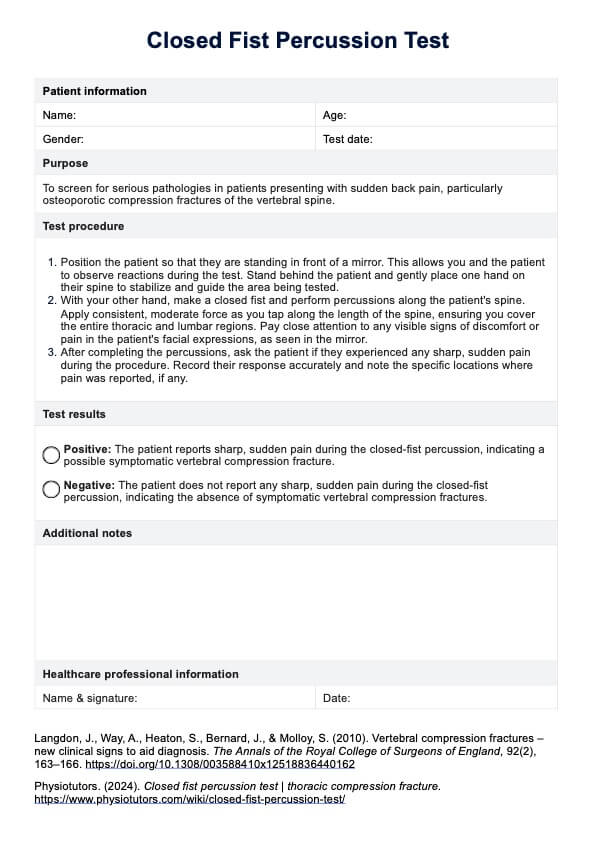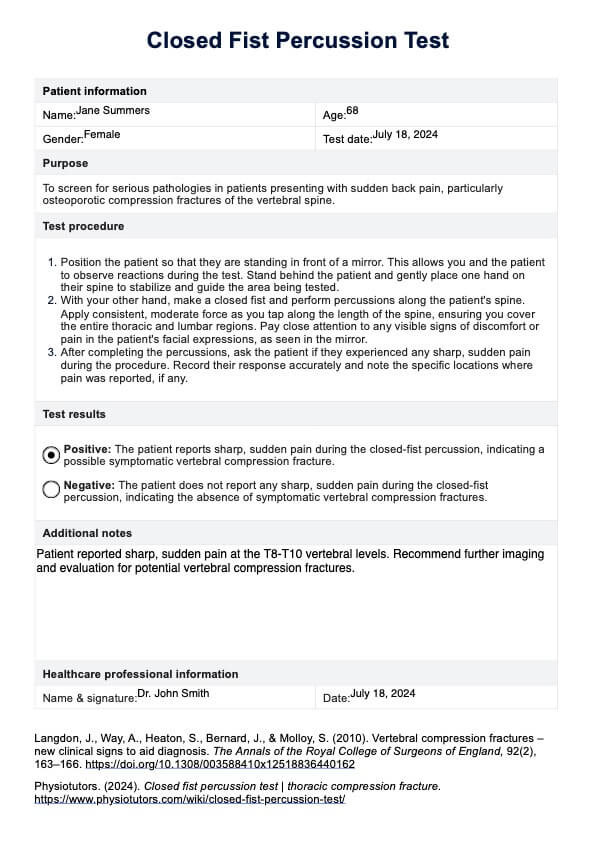Closed Fist Percussion Test
Discover how to perform the Closed Fist Percussion Test for vertebral fractures with our template. Learn benefits, steps, and FAQs for accurate patient assessment.


What are compression fractures?
Compression fractures occur when one or more bones in the spine (vertebrae) collapse. This can lead to significant pain, decreased height, and a hunched-forward posture known as kyphosis. These fractures are most commonly caused by osteoporosis, a condition where bones become weak and brittle, making them more susceptible to breaking from minor stress or trauma.
Other causes include trauma from falls or accidents, metastatic cancer that weakens the bones, and certain diseases that affect bone strength. Moreover, symptoms typically include sudden onset of back pain, especially when standing or walking, and the pain often decreases when lying down.
How to assess vertebral compression fractures
Assessing vertebral fractures involves a combination of patient history, physical examination, and imaging studies. During the patient history intake, healthcare providers look for risk factors such as age, osteoporosis, history of cancer, or recent trauma. Physical examination includes checking for tenderness over the vertebrae, assessing spinal alignment, and looking for any signs of neurological impairment, such as weakness or numbness.
Imaging studies are crucial for confirming the diagnosis of vertebral fractures. X-rays are typically the first imaging modality used to identify fractures. If further detail is needed or if there is suspicion of more complex injuries, MRI or CT scans can provide more detailed views of the bone and surrounding tissues. These imaging tools help determine the extent of the fracture and plan appropriate treatment strategies.
What is the Closed Fist Percussion Test?
The Closed Fist Percussion Test is a physical examination technique to detect vertebral compression fractures. The test involves the examiner standing behind the patient and using a closed fist to apply percussions along the patient's spine. This method helps identify areas of the spine that might be tender or painful, which could indicate a fracture. The patient is asked to stand in front of a mirror to observe their reactions during the test.
According to Langdon et al. (2010), the closed-fist percussion test has a high sensitivity (87.5%) and specificity (90%) for detecting symptomatic vertebral fractures. This means the test is reliable for identifying patients with vertebral compression fractures and ruling out those who do not. A positive test result is indicated by the patient experiencing sharp, sudden pain during the percussions, which suggests the presence of a fracture. This simple yet effective test can be essential in screening patients with sudden back pain.
How to perform the Closed Fist Percussion Test
Performing the Closed Fist Percussion Test is straightforward and can be done quickly in a clinical setting. However, it is important to follow the steps carefully to ensure accurate results and avoid causing unnecessary discomfort to the patient.
First, position the patient to stand in front of a mirror. This allows you and the patient to observe reactions during the test. Stand behind the patient and gently place one hand on their spine to stabilize and guide the area being tested.
Next, with your other hand, make a closed fist and perform percussions along the patient’s spine. Apply consistent, moderate force as you tap along the length of the spine, ensuring you cover the entire thoracic and lumbar spine regions. Pay close attention to any visible signs of discomfort or pain in the patient’s facial expressions, as seen in the mirror.
Finally, after completing the percussions, ask the patient if they experienced any sharp, sudden pain during the procedure. This information will help determine if there are possible symptomatic vertebral compression fractures that require further investigation.
Closed Fist Percussion Test Template
Closed Fist Percussion Test Example
How does our Closed Fist Percussion Test template work?
Our Closed Fist Percussion Test template is designed to streamline the screening process for vertebral compression fractures. Healthcare professionals can ensure accurate assessment and documentation by following the structured steps. Here's how to use it:
Step 1: Download the template
Start by downloading the Closed Fist Percussion Test template from our resources. Ensure you have the necessary equipment and are familiar with the test procedure.
Step 2: Prepare the patient
Explain the test procedures to the patient, perform a health risk screening, and obtain informed consent. Record basic information such as the patient's age, height, weight, and relevant medical history.
Step 3: Perform the test
Position the patient as described in the template and carry out the closed fist percussions along the spine. Observe the patient's reactions and ask about any pain experienced during the test.
Step 4: Document the results
Use the interpretation options in the template to record whether the test results are positive or negative. Note any specific details about the patient's pain response and the exact pain locations.
Step 5: Provide additional notes and follow-up
Complete the additional notes section with any relevant information or observations. Based on clinical assessment and the test results, plan the next steps, including further diagnostic imaging or referral to a specialist.
Benefits of using our template
Using our Closed Fist Percussion Test template simplifies the testing process and ensures accurate data collection. Here are three key benefits:
Standardization
Our template provides a consistent structure for conducting the Closed Fist Percussion Test, ensuring that all necessary steps are followed and recorded accurately. This standardization minimizes errors and enhances the reliability of the results.
Efficiency
Healthcare professionals can save time setting up and administering the test using a pre-designed template. The template includes all essential fields and guidelines, making the process more streamlined and efficient.
Comprehensive documentation
The template ensures comprehensive documentation of patient data, test conditions, and results. This thorough record-keeping facilitates better analysis and follow-up of clinical consequences, allowing for more effective patient progress and outcomes monitoring.
Reference
Langdon, J., Way, A., Heaton, S., Bernard, J., & Molloy, S. (2010). Vertebral compression fractures – new clinical signs to aid diagnosis. The Annals of the Royal College of Surgeons of England, 92(2), 163–166. https://doi.org/10.1308/003588410x12518836440162
Commonly asked questions
The Closed Fist Percussion Test is a clinical examination technique for detecting vertebral compression fractures. It involves percussing the spine with a closed fist to elicit pain responses.
According to Langdon et al. (2010), the test has a sensitivity of 87.5% and a specificity of 90% for detecting symptomatic fractures of the spine.
Patients presenting with sudden back pain, especially older adults or those with osteoporosis, should undergo this test to screen for potential vertebral compression fractures.
No special equipment is needed for the test, making it simple and easy to perform in any clinical setting.
If the test is positive, indicating a possible vertebral compression fracture, further diagnostic imaging such as X-rays, MRI, or CT scans should be performed, and a referral to a specialist may be necessary.







































































































